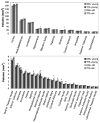Remote sites of structural atrophy predict later amyloid formation in a mouse model of Alzheimer's disease
- PMID: 20035883
- PMCID: PMC2823970
- DOI: 10.1016/j.neuroimage.2009.12.070
Remote sites of structural atrophy predict later amyloid formation in a mouse model of Alzheimer's disease
Abstract
Magnetic resonance (MR) imaging can provide a longitudinal view of neurological disease through repeated imaging of patients at successive stages of impairment. Until recently, the difficulty of manual delineation has limited volumetric analyses of MR data sets to a few select regions and a small number of subjects. Increased throughput offered by faster imaging methods, automated segmentation, and deformation-based morphometry have recently been applied to overcome this limitation with mouse models of neurological conditions. We use automated analyses to produce an unbiased view of volumetric changes in a transgenic mouse model for Alzheimer's disease (AD) at two points in the progression of disease: immediately before and shortly after the onset of amyloid formation. In addition to the cortex and hippocampus, where atrophy has been well documented in AD patients, we identify volumetric losses in the pons and substantia nigra where neurodegeneration has not been carefully examined. We find that deficits in cortical volume precede amyloid formation in this mouse model, similar to presymptomatic atrophy seen in patients with familial AD. Unexpectedly, volumetric losses identified by MR outside of the forebrain predict locations of future amyloid formation, such as the inferior colliculus and spinal nuclei, which develop pathology at very late stages of disease. Our work provides proof-of-principle that MR microscopy can expand our view of AD by offering a complete and unbiased examination of volumetric changes that guide us in revisiting the canonical neuropathology.
Copyright 2009 Elsevier Inc. All rights reserved.
Figures









Similar articles
-
Magnetic resonance imaging for monitoring therapeutic response in a transgenic mouse model of Alzheimer's disease using voxel-based analysis of amyloid plaques.Neuroreport. 2014 Mar 5;25(4):211-8. doi: 10.1097/WNR.0000000000000067. Neuroreport. 2014. PMID: 24518227 Free PMC article.
-
In vivo measurement of plaque burden in a mouse model of Alzheimer's disease.J Magn Reson Imaging. 2006 Nov;24(5):1011-7. doi: 10.1002/jmri.20751. J Magn Reson Imaging. 2006. PMID: 17036339 Free PMC article.
-
Amyloid-β plaque formation and reactive gliosis are required for induction of cognitive deficits in App knock-in mouse models of Alzheimer's disease.BMC Neurosci. 2019 Mar 20;20(1):13. doi: 10.1186/s12868-019-0496-6. BMC Neurosci. 2019. PMID: 30894120 Free PMC article.
-
Anatomical and functional phenotyping of mice models of Alzheimer's disease by MR microscopy.Ann N Y Acad Sci. 2007 Feb;1097:12-29. doi: 10.1196/annals.1379.006. Ann N Y Acad Sci. 2007. PMID: 17413006 Review.
-
Magnetic resonance imaging of Alzheimer's pathology in the brains of living transgenic mice: a new tool in Alzheimer's disease research.Neuroscientist. 2007 Feb;13(1):38-48. doi: 10.1177/1073858406295610. Neuroscientist. 2007. PMID: 17229974 Review.
Cited by
-
Magnetic Resonance Imaging in Animal Models of Alzheimer's Disease Amyloidosis.Int J Mol Sci. 2021 Nov 25;22(23):12768. doi: 10.3390/ijms222312768. Int J Mol Sci. 2021. PMID: 34884573 Free PMC article. Review.
-
Age‑ and brain region‑associated alterations of cerebral blood flow in early Alzheimer's disease assessed in AβPPSWE/PS1ΔE9 transgenic mice using arterial spin labeling.Mol Med Rep. 2019 Apr;19(4):3045-3052. doi: 10.3892/mmr.2019.9950. Epub 2019 Feb 12. Mol Med Rep. 2019. PMID: 30816468 Free PMC article.
-
Longitudinal Assessment of Amyloid Pathology in Transgenic ArcAβ Mice Using Multi-Parametric Magnetic Resonance Imaging.PLoS One. 2013 Jun 19;8(6):e66097. doi: 10.1371/journal.pone.0066097. Print 2013. PLoS One. 2013. PMID: 23840405 Free PMC article.
-
Mouse model of rare TOR1A variant found in sporadic focal dystonia impairs domains affected in DYT1 dystonia patients and animal models.Neurobiol Dis. 2016 Sep;93:137-45. doi: 10.1016/j.nbd.2016.05.003. Epub 2016 May 7. Neurobiol Dis. 2016. PMID: 27168150 Free PMC article.
-
Fully automated rodent brain MR image processing pipeline on a Midas server: from acquired images to region-based statistics.Front Neuroinform. 2013 Aug 13;7:15. doi: 10.3389/fninf.2013.00015. eCollection 2013. Front Neuroinform. 2013. PMID: 23964234 Free PMC article.
References
-
- Buckner RL, Snyder AZ, Shannon BJ, LaRossa G, Sachs R, Fotenos AF, Sheline YI, Klunk WE, Mathis CA, Morris JC, Mintun MA. Molecular, structural, and functional characterization of Alzheimer’s disease: evidence for a relationship between default activity, amyloid, and memory. J Neurosci. 2005;25:7709–7717. - PMC - PubMed
-
- Busatto GF, Diniz BS, Zanetti MV. Voxel-based morphometry in Alzheimer’s disease. Expert Rev Neurother. 2008;8:1691–1702. - PubMed
-
- Busch C, Bohl J, Ohm TG. Spatial, temporal and numeric analysis of Alzheimer changes in the nucleus coeruleus. Neurobiol Aging. 1997;18:401–406. - PubMed
-
- Chung MK, Worsley KJ, Paus T, Cherif C, Collins DL, Giedd JN, Rapoport JL, Evans AC. A unified statistical approach to deformation-based morphometry. Neuroimage. 2001;14:595–606. - PubMed
Publication types
MeSH terms
Substances
Grants and funding
LinkOut - more resources
Full Text Sources
Medical

